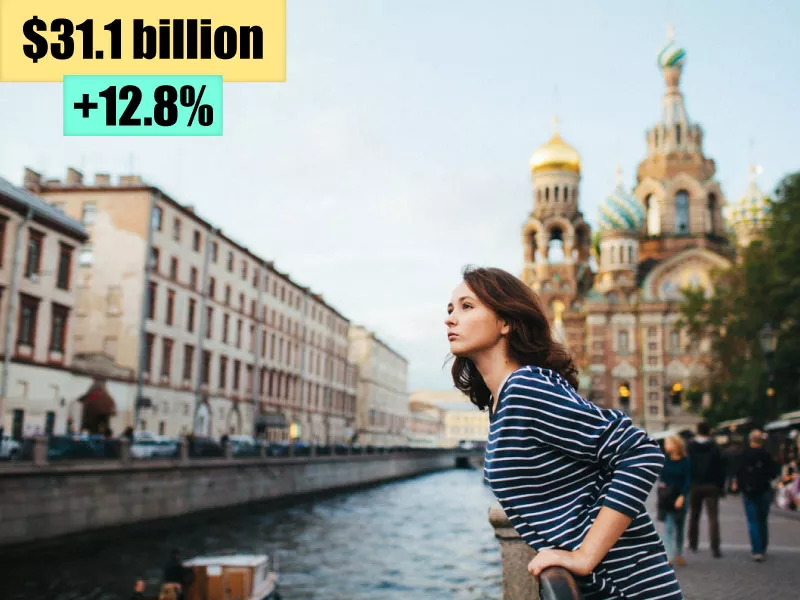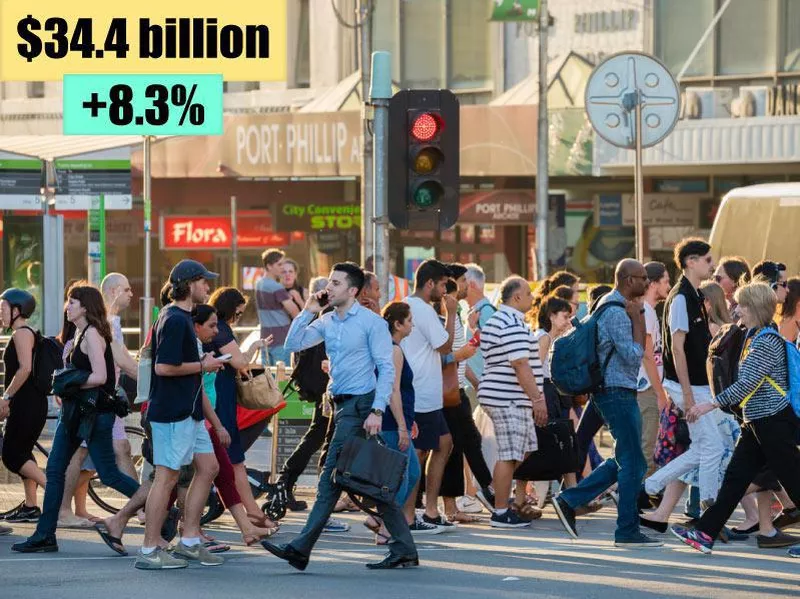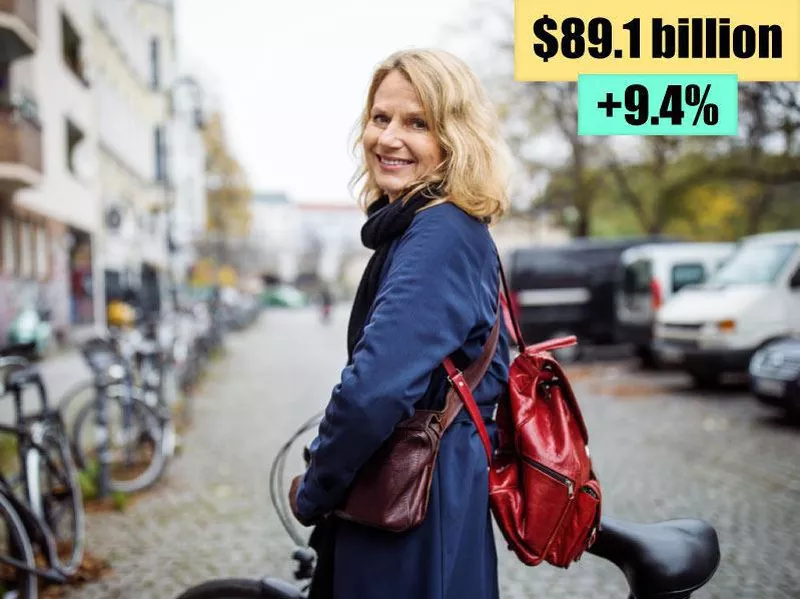Tourism is one of the largest industries in the world and can be a vital source of revenue for nations across the globe. But who are these tourists — the people actually spending money on travel — and where are they from?
Thanks to statistics compiled by the World Tourism Organization (WTO), the tourism agency of the United Nations, it’s easy to see which countries’ residents are making travel a top priority in their budgets. The World Tourism Barometer, updated regularly by the organization, highlights short-term travel trends, including how much money the residents of various countries are spending on travel.
Perhaps unsurprisingly, countries with large populations and healthy economies lead the pack for travel spending, though nearly all countries are reporting higher travel expenditures these days.
Curious to know which country’s residents spend the most on travel? Some of the answers may surprise you.
15. Dutch People

Getty Images
People who live in the Netherlands spent $19.5 billion to travel the world in 2017, an increase of 5.4% from the year before.
Dutch tourists, or “toeristen” as they’re called in their native tongue, go on vacation at least three times per year, preferring to explore Germany, France, Spain, Belgium and Austria, according to the OECD.
Young people tend to look for new destinations to visit, while older travelers seek out spots that will allow them to kick back and relax. While in some countries travel agents remain popular, the Dutch are on the cutting edge, doing most of their travel booking online.
The Netherlands is also a popular country for incoming tourists, of course, welcoming 17.9 million visitors in 2017.
14. Belgians

Getty Images
Belgians love to travel — and it shows in the healthy amount they spend to get out of town. This number is also on the rise; they spent 4.4 percent more on travel in 2017 than the year before.
Some of their favorite destinations include France, Italy, Spain and the United Kingdom. It’s easy for Belgians to get around, thanks to five well-connected airports — the Brussels Airport, for instance, offers direct flights to 206 destinations around the world.
Of course, with its beer, waffles, chocolate and many historical sites, Belgium is a pretty awesome country to explore in its own right — case in point, 8.4 million people visited Belgium in 2017, primarily spending their time in three locations: Flanders, Wallonia and Brussels.
13. Spaniards

Getty Images
Spain is one of the hottest travel destinations for residents of many European countries, but where and how do the Spanish travel?
When they’re not traveling within Spain (the most popular choice among Spaniards, who famously love their home country), they prefer to vacation in the United States, France, Portugal, Italy, Mexico, the Dominican Republic, Ecuador and Brazil. In the United States, Spaniards tend to flock to New York, Florida and the West Coast.
As the country rebounds from an economic crisis, healthy travel expenditure is a positive indicator that recovery is in process.
12. Singaporeans

Getty Images
Singaporeans took a collective 9.8 million international trips last year. The country’s 6 million residents are inspired by the activities offered at their destination, as well as travel website reviews, past travel experiences and word of mouth, according to a survey conducted by Criteo, an internet advertising company.
Singapore’s residents are most likely to visit Malaysia, Thailand, Hong Kong, Indonesia, Taiwan, Japan and Australia. The majority of Singaporeans prefer to travel by air, while a small group chooses to travel by sea, according to the Singapore Department of Statistics.
11. Hong Kongers

Getty Images
Since Hong Kong spans a little more than 1,100 square kilometers (or 400 square miles), its residents often opt to travel outside the region for vacation. That’s one reason why travelers in Hong Kong, an autonomous administrative region in southeastern China, are spending so much on travel.
Hong Kong is also one of the most densely populated areas of the world, with more than 6,500 people per square kilometer, so there are a lot of people living in Hong Kong with money to spend. Plus, there are more than 100 airlines offering flights from Hong Kong to 190 destinations around the world, which makes jetting off for a trip very easy.
An analysis by Mastercard predicts that travel will continue to be a top priority for the 7 million people who live in Hong Kong — the credit-card company estimates that Hong Kong residents will take as many as 6.8 million trips by 2021.
10. Italians

After a decade of flat spending, Italians are finally spending more on travel, according to an analysis by Banca D’Italia. Italians took 64.5 million trips abroad in 2017, spending time in Greece, Spain and Austria. Other popular destinations were Switzerland, France, United Kingdom and China.
Italians primarily travel for vacation, visiting cities with art, cultural tourism and seaside activities. In the United Kingdom, for example, they prefer to visit London, Scotland and regions in the south east and south west. While visiting the UK, they spend their time shopping, eating out at restaurants, drinking in pubs and visiting parks, gardens, museums and art galleries.
9. South Koreans

Getty Images
Roughly half of all South Koreans traveled abroad in 2017, contributing to the country’s robust tourism spending.
The nation’s appetite for international exploration is growing thanks to greater general awareness of events and destinations outside of South Korea, rising incomes and more vacation time. In addition, South Korea’s government made Oct. 2 a one-time holiday in 2017, which extended the country’s Chuseok harvest festival and likely prompted people to extend their vacations.
One popular destination among South Koreans for long-haul trips is the United States, thanks to its large National Park system, shopping opportunities, theme parks, restaurants and other activities. Their favorite U.S. cities include Los Angeles, San Francisco, Las Vegas, Seattle, New York and Washington, D.C.
8. Russians

Getty Images
Russians are clearly becoming more interested in traveling, which the WTO largely credits to a growing middle class.
While the rest of the world has become more tech-savvy when it comes to researching and booking travel, researchers found that many Russians still tend to plan trips the old-fashioned way — with brochures and magazines, or by seeking out travel agents.
Russian travelers are inclined to visit places like Prague, Munich and Paris, as well as Poland, Scandinavia and Mediterranean countries. They tend to avoid overly touristy areas and prefer luxurious accommodations over budget arrangements like backpacking.
7. Canadians

Getty Images
Canada’s 37 million residents tend to book trips to Mexico, the United States, Cuba, the Dominican Republic, Jamaica, France, Italy, the United Kingdom and other European countries, according to a report from the Conference Board of Canada.
When they travel to the United States, Canadians like to visit New York, Las Vegas, Miami, Orlando, Maui and Boston, though perhaps unsurprisingly, their destination preferences fluctuate based on their age.
With its 3.85 million square miles of terrain (including 47 stunning national parks), Canada also saw an increased number of travelers in 2017, welcoming 20.8 million international visitors.
6. Australians

Getty Images
The 25 million people who call Australia home spent a ton of money on tourism in 2017. A very high number of Aussies have passports (14 million, or 57 percent of the population), which means they can easily travel internationally for business or pleasure.
The country’s propensity for travel is helping to keep many travel agents in business, even in an era of online trip booking and planning tools — 70 percent of Australians booked at least one part of their trip through a travel agent in 2017.
Aussies like to visit nearby New Zealand and Indonesia, followed by the United States, the United Kingdom, Thailand, China and Singapore, according to the Australian Federation of Travel Agents. The country’s residents must love water, too, as one in 18 Australian residents (1.3 million people) took a cruise in 2017.
5. French People

Getty Images
When they’re not eating croissants and coq au vin, the French are on the move, though they didn’t travel a whole lot more in 2017 than in the year prior.
French tourists took more than 44 million overnight trips and 29 million day trips in 2017, choosing to spend their time in Portugal, Belgium, Germany, Great Britain, Italy and Spain above other destinations, according to the OECD.
What do the French consider when picking a travel destination? The availability of activities, followed by whether a trip is a “once-in-a-lifetime experience,” according to Wesgro, the tourism and trade promotion agency for the Western Cape. They make decisions based on reviews they read on TripAdvisor, deals they find online and by reading content from travel brands and tourism bureaus.
4. Brits

Getty Images
A record number of United Kingdom residents journeyed abroad in 2017, according to the Office of National Statistics, so it’s not surprising that they spent so much on travel. They took 72.8 million trips abroad, traveling primarily for vacation (or “holiday,” as they say in the UK) and to visit friends and family.
Spain and the Balearic Islands were the most popular destinations among UK travelers, followed by France, the Canaries, Italy and the United States. In England specifically, residents spent 299 million nights traveling within their own country, taking both business trips and vacations that averaged about three nights per trip, according to Visit Britain.
3. Germans

Getty Images
The most popular European destinations for German travelers are Spain, Italy, Austria, Croatia, Greece, Benelux, France and the United Kingdom, according to research by ADAC, a German automobile club that studies local travel trends.
Outside of Europe, Germans like to visit the United States, Far East countries like China and Thailand, the Caribbean islands, Egypt and Canada, to name a few.
Perhaps one reason why Germans spent so much on travel is because they like to take fairly length vacations — ADAC found that 75 percent of German travelers spend eight to 21 days on holiday.
Interestingly, the majority of Germans — 74 percent — also prefer to travel without children. (Proving Germans are a very smart people.)
2. Americans

Getty Images
Though Americans are notoriously bad at using all of their paid vacation time off, they still manage to spend a significant chunk of change on tourism.
Their top destinations? Mexico (by a landslide), followed by Canada, United Kingdom, Dominican Republic, France, Italy and Germany, according to the National Travel and Tourism Office.
American travelers like to relax, apparently, with an estimated 56 percent of people reporting that they traveled for vacation, followed by 27 percent who were visiting friends and relatives. On average, Americans traveled for 16.6 nights, and took 2.5 international trips.
1. Chinese People

Getty Images
With its robust economy and massive population of 1.39 billion people, perhaps it’s no surprise that China tops the list for tourism spending. And China’s interest in travel is growing, too.
What’s behind this growth? Chinese tourists are earning higher wages and can more easily access travel and flight information online, according to a 2018 analysis by McKinsey. On top of that, dozens of countries have eased their visa restrictions, which makes it easier for Chinese tourists to visit.
Plus, the majority of Chinese tourists — some 70 percent — travel with friends and family, which is likely one reason why they spend the most money per trip among international travelers.
